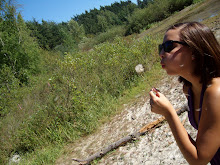Rain, Steam, and Speed- The Great Western Railway by J.M.W. Turner
1844, Oil on canvas, 91 x 121.8 cm
The National Gallery, London
I understand that Turner doesn't appeal to many at first. Even I will admit that when I first saw this, I was not impressed with Turner. It seemed to me like a poorly done painting with little attention to detail. A lot of Turner's work has this same blurred look. Some of his paintings are hard to even tell what they are- the name is usually your only clue. But today I was studying early industrialization in my World History book and stumbled upon this image and realized I had been missing the essence to Tuner's work all along.
Industrialization was huge. Of course some hated the idea of industry and favored manual labor, but the majority viewed machinery as magic. When you could master a machine, or invent a new way to do something, you were heroic. My textbook said something like machinery displayed "the triumph of imagination over nature." J.M.W. Turner was an artist who admired this triumph as you can see by his work Rain, Steam, and Speed- The Great American Railway. Those who favored mechanization viewed it as romantic. Let me explain, if you look at the painting it seems as if the locomotive has no end and is zooming at you with no clear lines or definition. Turner was inspired by industrialization and he made the locomotive and railway seem as if it was a part of nature. The clouds and steam become one as the landscape and railway combine elements. This is so beautiful to me. I would love to go back in time and be there during a time when people were discovering new ways to do things left and right. At this time, industry portrayed endless possibilities and I feel that Turner adequately portrays this excitement. One can merely imagine where the locomotive was going or what it carried, it was simply endless.
Turner's possibilities were endless.





No comments:
Post a Comment